Review by Pete Vack
Lead Photo
16-year-old Lynn Hirsch, center, Carla Haug, also 16, at left, and Mrs. Trudy Hirsh, 20, right celebrate the opening of Jerry Hirsch’s Lynndale Farms Road Racing Course.
The 1960s were a tumultuous time; from the hope and promise of the late 1950s to the precipitous drop off when everything seemed to go wrong, it was a decade in dire straights. However, between 1963 and 1966 there was a brief respite before the storm, the four years after the healing of the Kennedy assassination to the onset of the escalation of the war in Vietnam.
And good years too, for a young SCCA racer named Bill Schley, son of Mr. and Mrs. Norm Schley of Waukesha, Wisconsin, who bought a Fiat Abarth Berlina 1000 and went racing, setting records and winning events at a nearby track called Lynndale Farms.
A half century later, same Bill Schley attended a boat show in nearby Pewaukee. There he visited a booth set up by the local historical society. And there he found a three-ring binder full of newspaper clippings about Lynndale Farms. The gent from the historical society took notice of Bill’s interest and asked if he knew anything about the track. Bill opened the binder and showed him an article headlined “Schley Wins One Event, is Second Overall for Sedans at Lynndale.”
“That’s me”, said Bill. And thus began the making of Bill’s book, Four Short Years, The Lynndale Farms Road Racing Course Story. Using his own photos, 8mm films, newspaper clippings, results and magazine articles, Bill stitched together the history of the little-known racetrack, which should have rivaled Cliff Tufte’s Road America. But unlike the track at Elkhart Lake, Lynndale did not survive.
Getting it right
Not that developer/real estate broker Jerry Hirsch didn’t try, He did all the right things; laid out a 2.5 mile track on an old dairy farm near Milwaukee, had professional drivers give him input for the design, made it so that 90 percent of the track could be seen by spectators, and got both SCCA and USAC in involved in promoting the events. He asked (and paid, no doubt) Stirling Moss to be at the inaugural event in 1963. He got all the hotshoes and champions to enter the races.
Hirsch was a fan of and a driver at Tufte’s Road America track, located about 60 miles away. He bought a Triumph TR4, got his entire family involved, including 16-year-old Lynn, who provided the name for the new track, Lynndale. He was a real sports car enthusiast; he put his heart into it, and around a half million dollars. What defeated him in the end was not for lack of heart, enthusiasm, money or trying.
Bill Schley asked local historian John Schoenknecht to help him put together the short life of Lynndale Farms. But there is not a great deal of text; instead, and fortunately, Schley has laid out every little snippet of news clippings he could gather about the event in chronological order. At first, this reviewer looked for the usual race results, and noted happily that his old acquaintance and local hero John Erickson attended the inaugural event racing his P1800 Volvo. But Schley’s book isn’t about results.
Instead, by design or accident, the clippings…well reproduced and easy to read…tell the story of the life and death of a road racing facility in a very effective manner. Clipping by clipping, we see the beginnings of the track, the inaugural event that led to high hopes, the reports of the SCCA races, and the need to increase the number of events held at the track to add additional income. Schley brings in original flyers and programs, reports from the SCCA “Sports Car” magazine, as well as local papers who seemed eager to give the track great publicity but ended up documenting its demise.
Too many courses for the horses?
Sports car racing was hot, still growing and yet, one wondered if there were enough cars, events and spectators to support another racing venue in Wisconsin. Was Lynndale doomed from the start? Schley recalled that in those days, he could go racing at ten different venues over a five state area in the Midwest, an amazing number of road racing courses for a farming area not in California or New England. But according to John Englebert, writing in the local Waukesha, Wisconsin Freeman newspaper, Meadowdale was in a bad state of repair, Wilmot was too small to hold an SCCA National, and the Milwaukee State Fair venue had “…so high a rental fee that most sports car clubs cannot afford to race there.” So in Wisconsin, that left Road America and Lynndale, and Road America limited its events to only two a year, the June Sprints and the 500 in the fall. There was a potentially huge crowd, coming from the nearby major centers of Madison, Milwaukee, Chicago and Minneapolis, and plenty of entries as Milwaukee and Chicago were a hotbed of imported car dealers and race drivers. Lynndale was shaping up to be one of the major road racing venues in the Midwest.
Weather or not
While there were events at Lynndale that enjoyed good weather, bad weather interfered with critical money raising events. John Englebert noted that in 1965, 10,000 paying spectators attended two events at Lynndale, both in lousy weather. “It enabled Hirsch to make a modest profit but not enough to ensure the coming season.” The need to add more events like car shows, motorcycle races, club meets, etc. became even more critical as instead of paying spectators, bad weather seemed to show up at key events. The races went on of course, but the people stayed home.
Dogs Bark, Racecars are Noisy
If that wasn’t enough, the locals objected. And loudly, armed with every trick in the book, legal and otherwise. At first, they allowed that there may be few races every year. But as it became clear that more events would be needed to support the track, the objections increased. As at Lime Rock, excessive noise was the main problem. (Lime Rock eventually offered “muffled events” to appease the community.) The battles raged in a series of Lisbon public hearings on the subject, and one opponent event took to broadcasting the noise of the race cars heard on the track to the townspeople to demonstrate the level. The locals fought over the nature and timing of the permits, the additional requests for events, the location of the residence of the business, raised the cost of the amusement license, and even showed a photograph of junk cars in the track perimeter (it turned out that the photo was taken nowhere near the facility). It was this fight to the finish that is so well recorded in Schley’s booklet, using notes and articles from the ever-vigilant yet fair Waukesha Freeman.
Welcome to the neighborhood of Lynndale Farms
Hirsch tried selling stock to help the financial situation, only to face more bad weather and uncertainty. But it all wore him down. Eventually, he turned the track into a development, called Lynndale Farms. Portions of the old track were used as part of the neighborhood roads and can be discerned today.
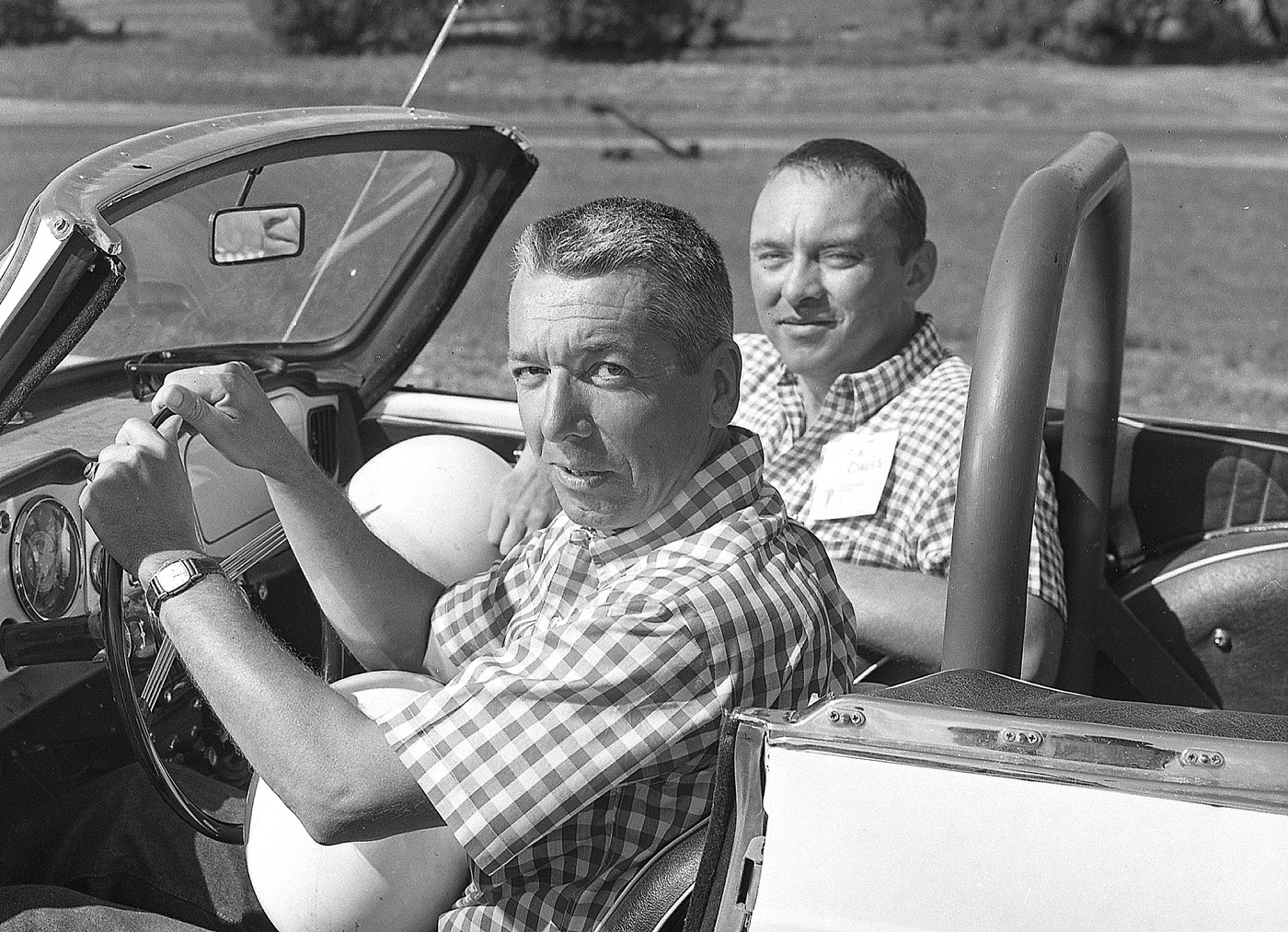
Die hard sports car nut Jerry Hirsch behind the wheel of his Triumph TR 4. With him is Joe Davis. The enthusiasm wouldn’t last.
The weather was part of it, the local community hammered in the last nails into the coffin, but in the end, as Jerry’s daughter Lynn recalled, it was the lack of support from the smaller sports car clubs, who often felt that “…they didn’t have to rent the track….and thought that if it wasn’t successful, they would pick it up at a decent price.” Hirsch was bitter. One could understand the noise issue, the weather, the lack of crowds. But not the lack of support from the very people for whom he built the track. After he closed it, he sold all of his sports cars, never bought another, and lost his enthusiasm. “He never went back to any part of that.”
A DVD too!
Schley’s book documents the troubles at the track, but also includes a delightful 37 minute DVD of color 16 mm film, taken at various events at Lynndale Farms. Mr. Norman Schley was on hand with an excellent camera to record son Bill’s victory with the Abarth 1000 on May 28, 1966. Corner worker Tom Mucklin captured even more racing during the 1964-65 seasons. A bit grainy and probably 8 mm, but captures the track and the cars very well.
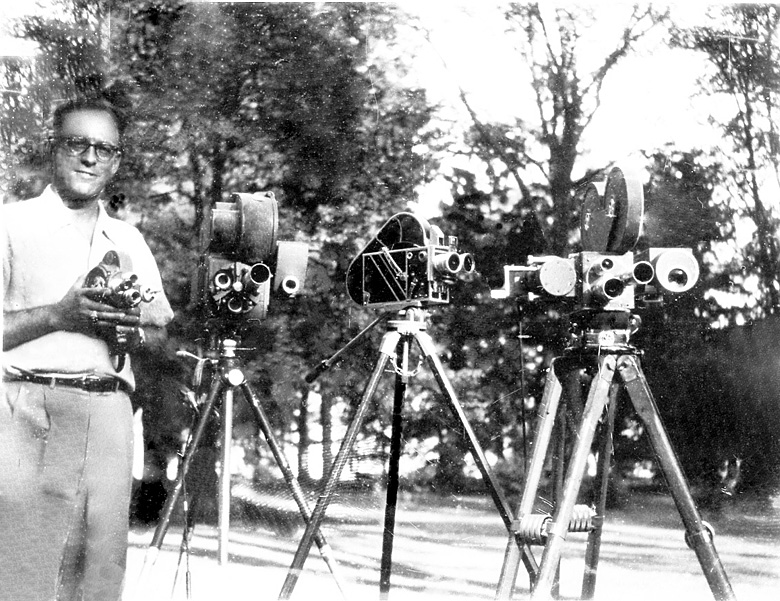
Bill’s father Norm was a very successful CPA, and he could afford the best cameras and equipment. The scenes from Lynndale captured by Norm have great color and resolution.
Lastly on the DVD is another scrapbook from 1964, put together by an unknown person but very well done. Most of clippings don’t appear in the book and focus on the race results rather than the community hearings. These were obtained after the book had been printed, so Schley wisely included them in the DVD.
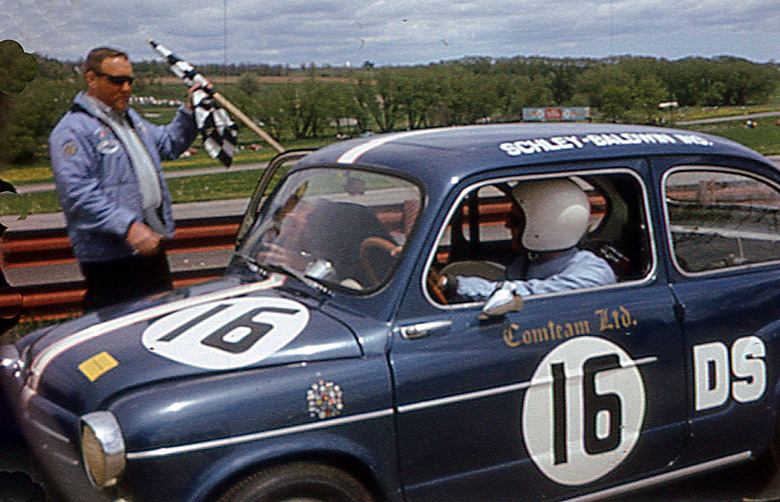
A scene taken from Norm Schley’s 16 mm movie camera, as Bill Schley takes the checkered flag with his Fiat Abarth 750/1000 Berlina.
So, a lot there. If you have purchased Thompson, Sports Car Racing in the South, Mid Atlantic American Sports Car races, Northeast American Sports Car Races, although very different in scope, you will want to add Four Short Years to your library and the cost is next to nothing. Here is how to order:
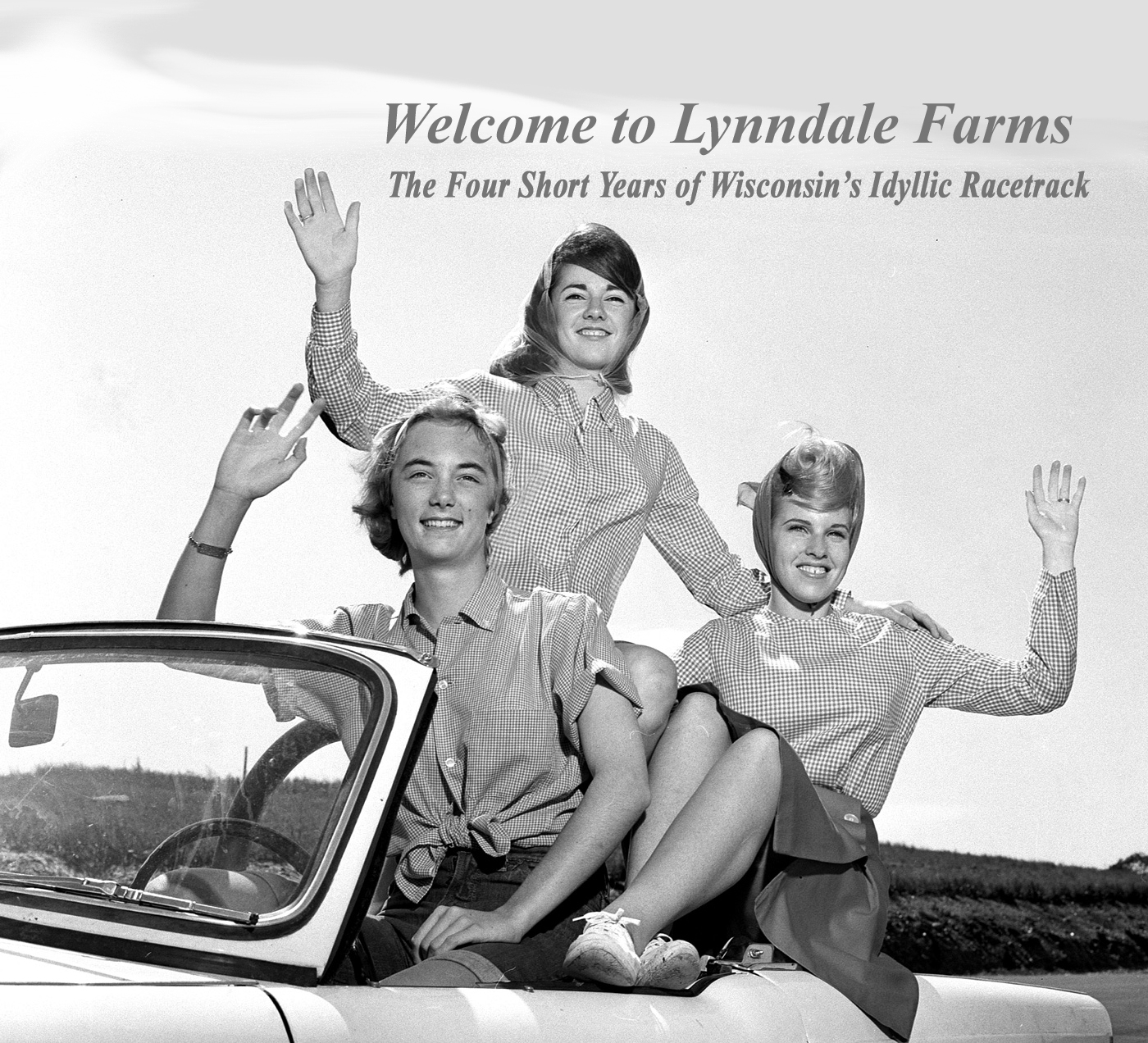
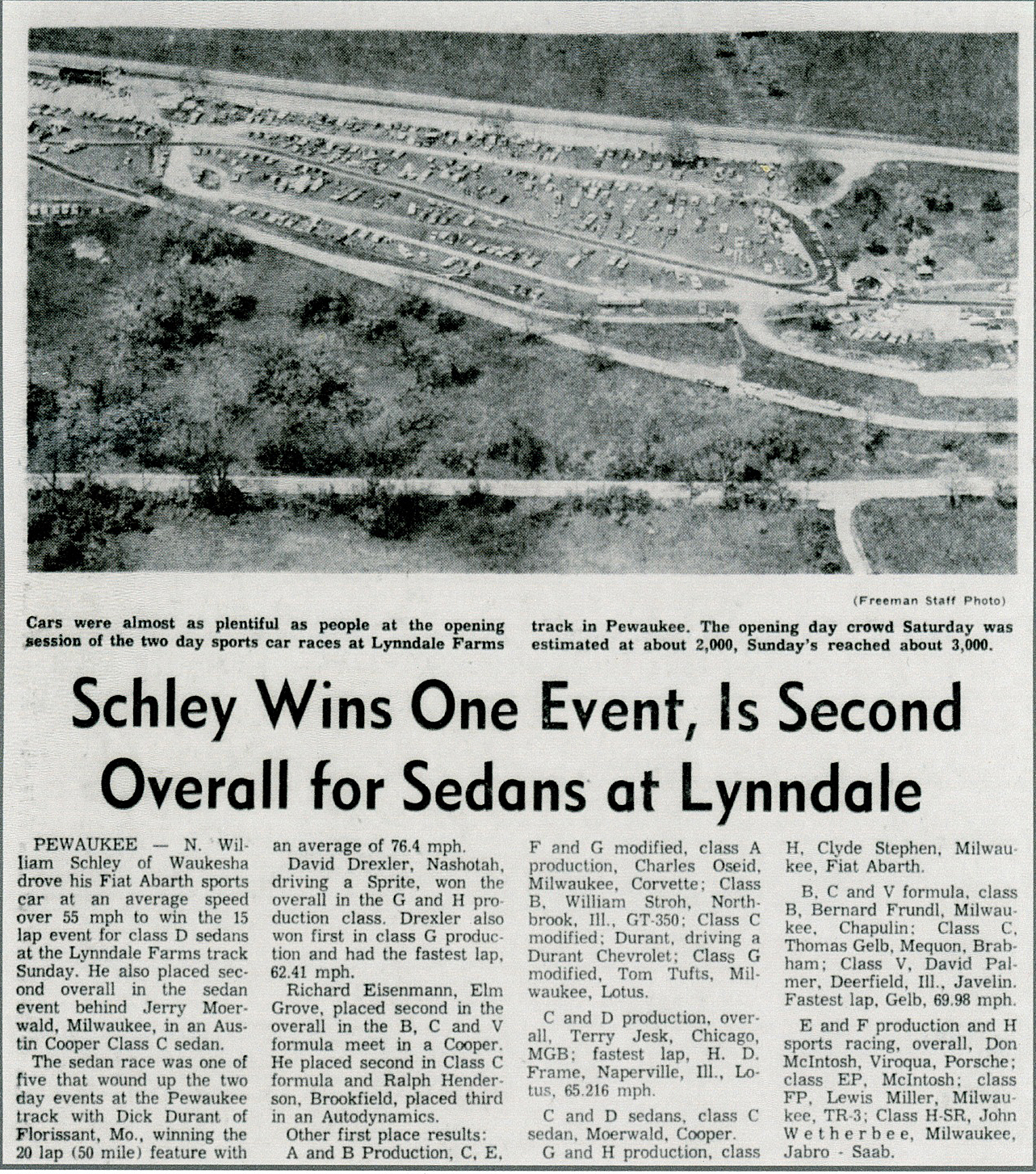
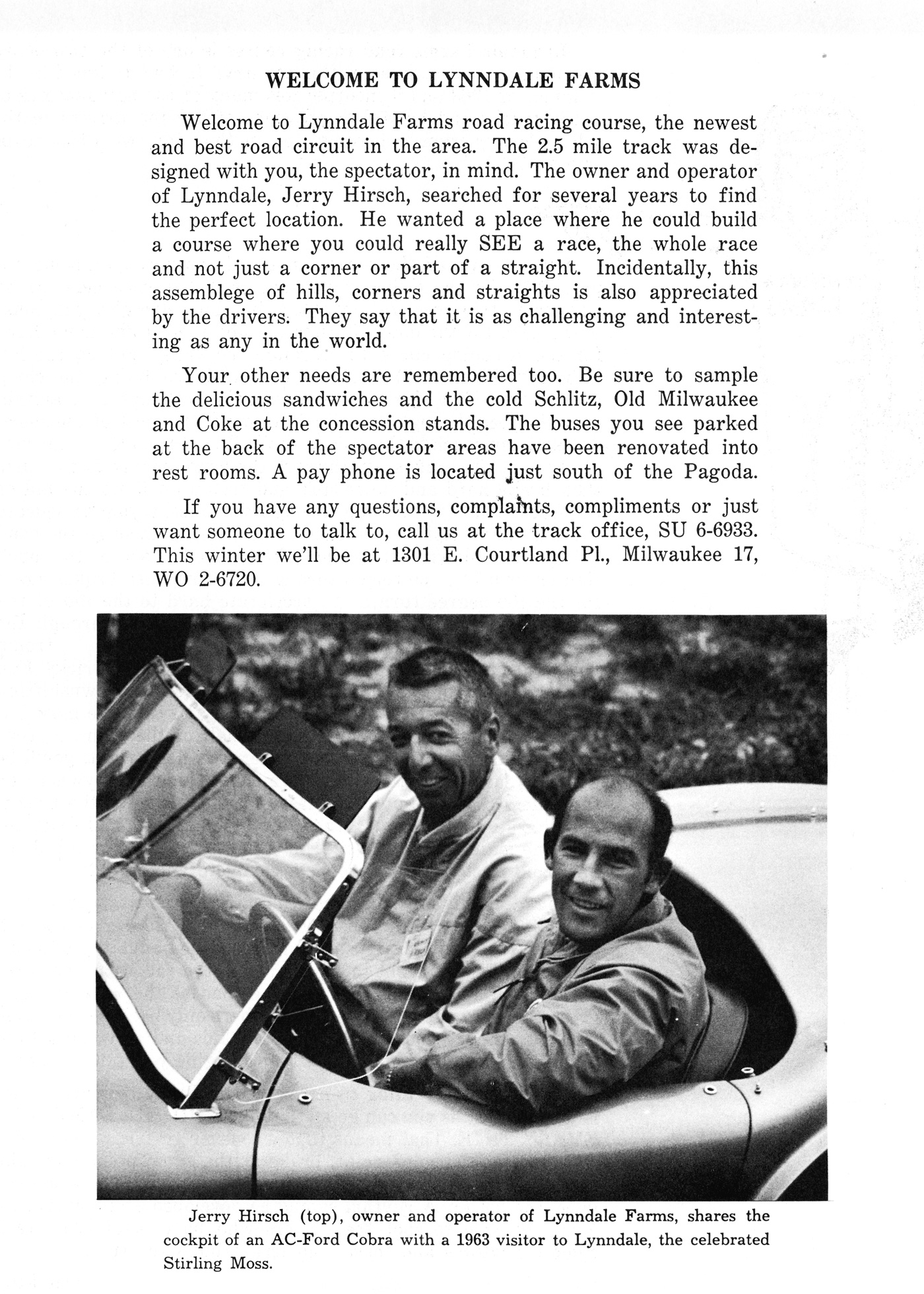
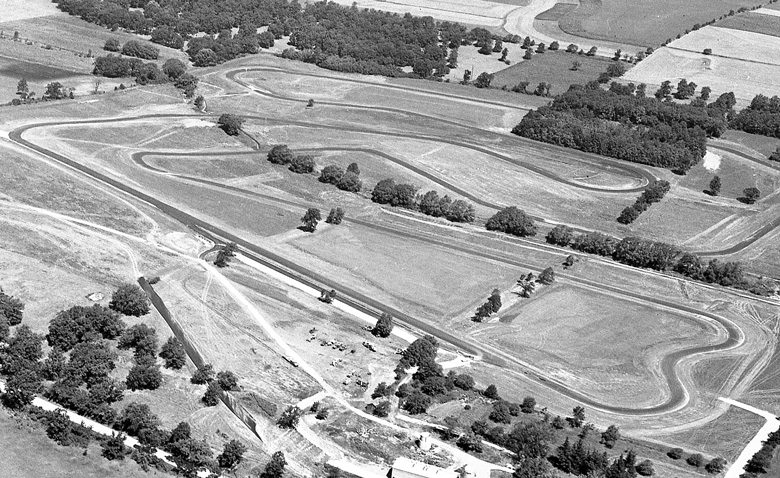
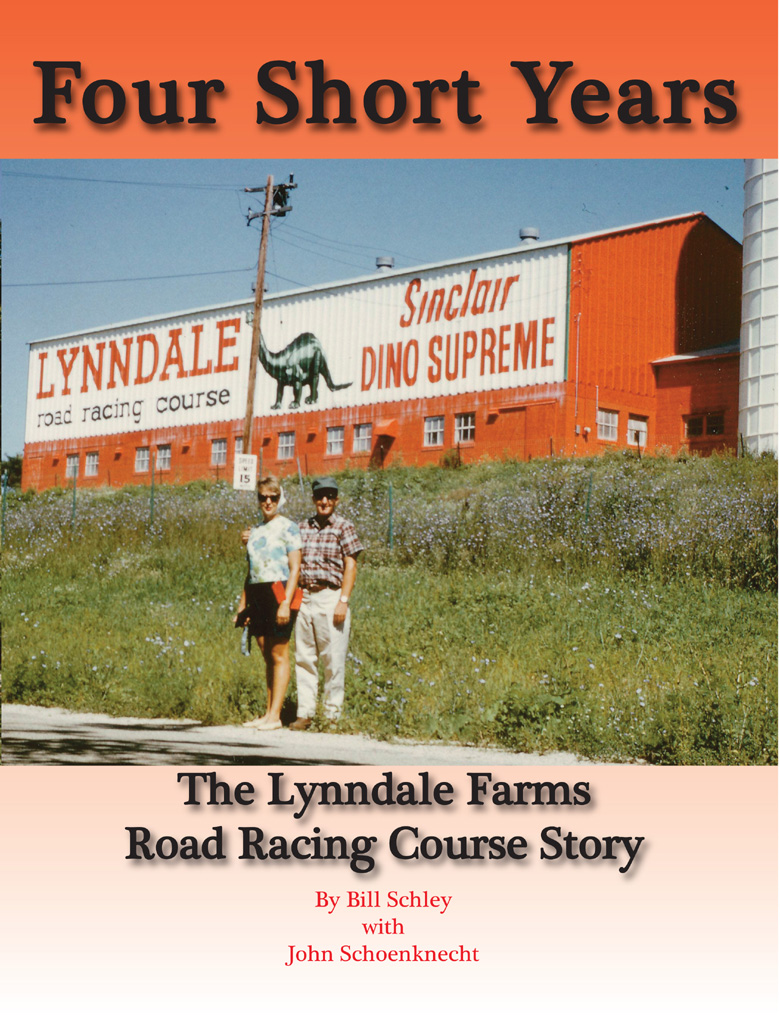
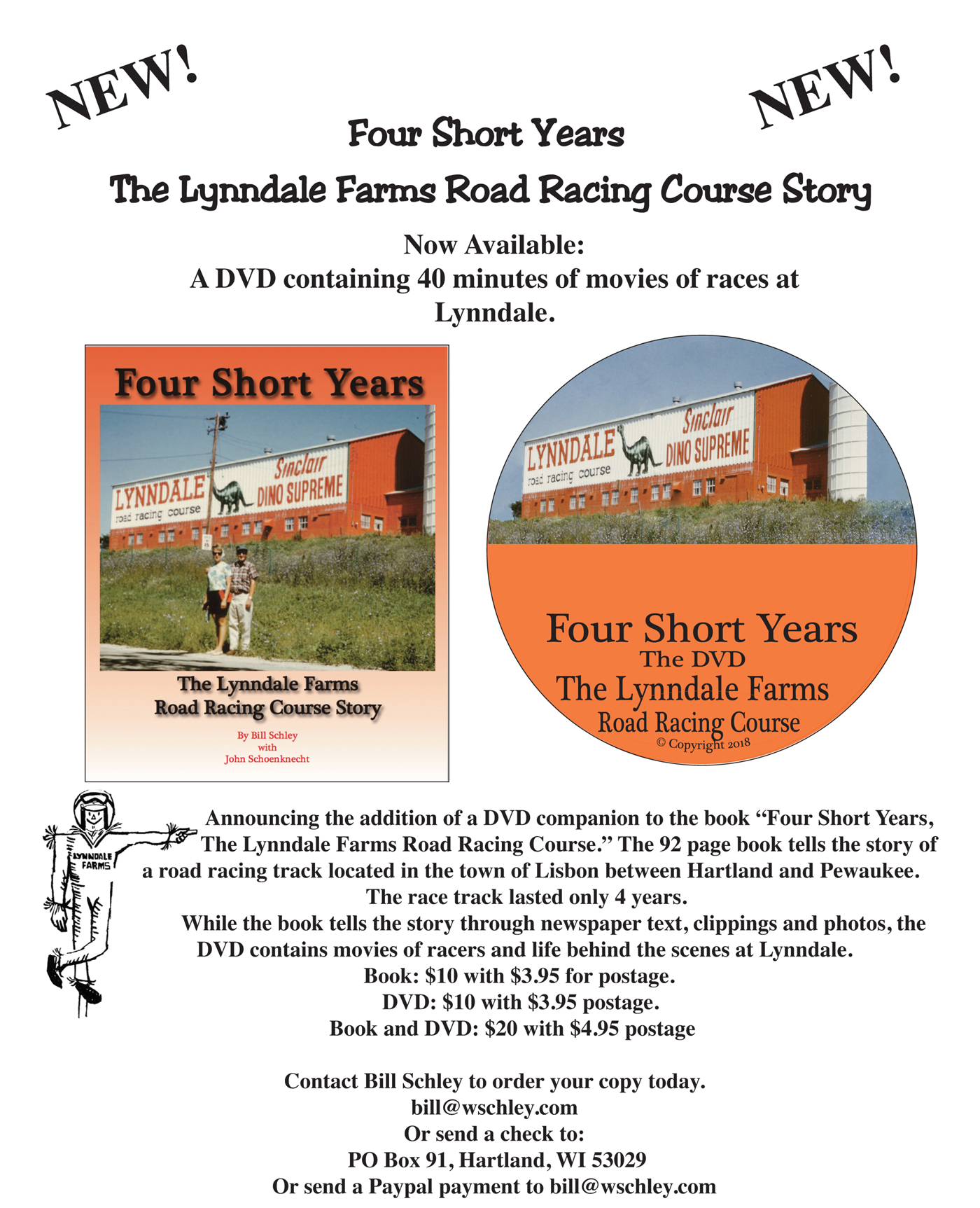
Very interesting article! In reading the newspaper clip, I noticed a name – David Palmer from Deerfield, IL – who was in the Formula V race. I believe David was a cousin of mine and used to come down with other members of his family to stay with us in Tampa. This always coincided with the Sebring 12 Hour race, which they would attend. I got my first introduction to racing from them. The would bore my parents but I found their talk of Stirling Moss, etc exciting. This led to me becoming track photographer at Sebring in the late 60s and early 70s.
I was at that race and had Stirling sign a large photo of himself. Yes it was a beautiful track. Very fan friendly.
I went college at the Milwaukee School of Engineering beginning in 1964. I loved British sports cars, but one day we had a visit from a Chrysler engineer who showed us a new Barracuda. It was one of the first American cars I thought I could like. The following summer I went to a sports car race at a place named Lynndale Farms, south of Milwaukee. I was amazed to see how much of this rambling track you could see from the start/finish line. It was one of the most interesting and memorable tracks I had ever seen. I was most impressed by a young man driving a light blue Barracuda name Scott Harvey, a Chrysler engineer. Watching his impressive performance, I knew I had to have a Barracuda. When I graduated in 1969, I immediately purchased a used one with a 4-speed for just $500. I feel fortunate to have experienced Lynndale Farms, which was a beautiful track and my Barracuda. I thank you for running this story about a little known but wonderful place and time in American Sports Car Racing history.
Thanks for publishing the article about the Lynndale Farms road racing circuit and Bill Schley’s book and DVD covering its four year history. I’m 74 years old and I’ve lived all my life within a ten mile radius of the Lynndale Farms property which is now a subdivision. Sadly during the four years it operated I was a BIG oval track racing fan ( Milwaukee Mile for two annual USAC Indy Car races and normally 4-5 USAC Stock Car races plus numerous short track dirt ovals for midget and modified racing ). I say sadly because after reading Bill Schley’s great book and viewing his video I now realize what I missed right in my ” backyard “. It’s a real shame during the four years it operated that Mother Nature wasn’t kind to the Lynndale Farms racing facility often adversely affecting the number of paying spectators. Based on the number of ” country club type ” road racing facilities now being successfully operated throughout the USA possibly Lyndale Farms was far ahead of the future needs of road racing drivers, teams and fans. I’m suggesting your readers take a few hours to discover what might have been in Pewaukee, WI– by reading and watching Bill Schley’s media offerings concerning the Lynndale Farms racing facility located in the center of Wisconsin’s ” Lake Country”.